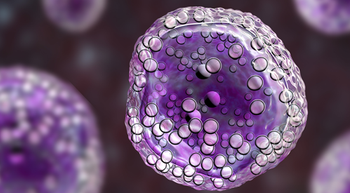
- August 2013
- Volume 7
- Issue 5
Improving Glycemic Control in Individuals With Cancer and Diabetes
It is estimated that 8%-18% of all cancer patients will have preexisting diabetes at the time they are diagnosed with cancer.
Denise Soltow Hershey, PhD, RN, FNP-BC
Assistant Professor, Michigan State University College of Nursing
It is estimated that 8%-18% of all cancer patients will have preexisting diabetes at the time they are diagnosed with cancer.1,2 Individuals with cancer and diabetes have higher mortality rates and a higher risk for developing infections and/or being hospitalized while receiving treatment when compared with individuals with cancer who do not have diabetes.1,3 The level of glycemic control during treatment has been hypothesized as one of the reasons for this difference.
Many factors can impact glycemic control in individuals with cancer and diabetes. These include chemotherapeutic agents; medications, such as corticosteroids; the impact symptoms may have on self-management of diet and exercise regimens; and lack of communication or coordination of care between oncologists and the patient’s primary care/diabetes providers. Patients also may perceive their cancer as being more severe, therefore prioritizing their cancer treatment over managing their diabetes.4-6
Patients with cancer and diabetes require a patient-centered approach to the management of both diseases while they are undergoing cancer treatment. The American Diabetes Association released new guidelines in 2012 for a patient-centered approach for the management of hyperglycemia in Type 2 diabetes,7 and these guidelines are available at www.diabetes.org. This patient-centered approach allows for individualization of glycemic goals based on the individual’s health status, complications, and resources, taking into account:
- Impact of fatigue and depression on ability to exercise
- Effect of chemotherapy and other medications on glycemic levels
- The influence of loss of appetite, nausea, or vomiting on diet
- How medications (eg, corticosteroids) and the disease process may affect nutritional state and tumor-induced alterations in metabolism
- Feelings of being overwhelmed with the challenges of managing both cancer and diabetes, including multiple appointments with various healthcare providers
To assist patients in the management of their diabetes, the American Association of Diabetes Educators has identified seven essential selfcare behaviors (Box).8 Oncology nurses should incorporate the assessment of each of these areas into their routine evaluations when they encounter a patient with diabetes and cancer, and provide education regarding the potential impact cancer and its treatment may have on glycemic levels.
Box. Self-Care Behavior for Patients with Diabetes8
1. Exercise or being active
2.Healthy eating; for cancer patients, this would include assisting them in developing a practical meal plan which includes eating regular meals that include carbohydrates, proteins, and fats.
3. Monitoring of blood glucose levels; how often patients check may need to be increased while they are receiving treatment for their cancer.
4. Taking medication as prescribed
5. Problem-solving, eg, how to watch for and handle hyper- and hypoglycemic levels as well as interruptions to their usual routine
6. Reducing risks for infections and other complications
7. Health coping
For more information and handsouts, visit www.diabeteseducator.org.
Oncology nurses may need to take on the role of care coordinator to assist patients in managing the care they receive from their oncologists and primary care providers and empower patients to communicate with their providers regarding their current level of glycemic control. The oncology nurse also may need to advocate for referrals to diabetes educators or an endocrinologist to assist patients in maintaining optimal glycemic control while they are receiving treatment.
The most important thing oncology nurses can do is to incorporate the use of evidence-based guidelines for diabetes management into their routine. These guidelines will assist the oncology nurse in providing the individualized care patients with diabetes and cancer will need in order to achieve optimal outcomes, reduce complications, and improve overall health-related quality of life.
References
- Barone BB, Yeh HC, Snyder CF, et al. Postoperative mortality in cancer patients with preexisting diabetes: systematic review and meta-analysis. Diabetes Care. 2010;33(4):931-939.
- Giovanucci E, Harlan D, Archer M, et al. Diabetes and cancer: a consensus report. CA Cancer J Clin. 2010;60(4):207-221.
- Barone BB, Yeh HC, Snyder CF, et al. Long-term all-cause mortality in cancer patients with preexisting diabetes mellitus: a systematic review and meta-analysis. JAMA. 2008;300(23):2754-2764.
- Hershey DS, Tipton J, Given B, Davis E. Perceived impact of cancer treatment on diabetes self-management. Diabetes Educ. 2012;38(6): 779-790.
- Leak A, Davis E, Houchin L, Mabrey M. Diabetes management and self-care education for hospitalized patients with cancer. Clin J Oncol Nurs. 2009;13(2):205-210.
- Psarakis H. Clinical challenges in caring for patients with diabetes and cancer. Diabetes Spectrum. 2006;19:157-162.
- Inzucchi S, Bergenstal R, Buse J, et al. Management of hyperglycemia in type 2 diabetes: a patient-centered approach: position statement of the American Diabetes Association (ADA) and the European Association for the Study of Diabetes (EASD). Diabetes Care. 2012;35(6):1364-1379.
- American Association of Diabetes Educators. AADE 7™ Self-Care Behaviors. http://www.diabeteseducator.org/. Accessed June 26, 2013.
Articles in this issue
about 12 years ago
Promoting HPV Vaccination for Girls and Boysabout 12 years ago
The Affordable Care Act: What Nurses Need to Know

















































































